Search results for: 'bronzezeit'
-
 Scarab with cartouche
Scarab with cartoucheThe scarab amulet has a cartouche and neb on the bottom. 18th to 20th dynasty of ancient Egypt.
Price: on request Scarab with twisted cord
Scarab with twisted cordScarab amulet with a twisted cord motive. Beautiful and well preserved piece from the Second Intermediate Period.
Price: on request Egyptian Scarab with sun beetle
Egyptian Scarab with sun beetleThe scarab amulet from Ramesside times has a beetle engraved in the lower side, flanked by two symbols.
Price: on request Scarab with magic spell
Scarab with magic spellThe hieroglyphs are of the so called anra design, a magic spell in the ancient Egyptian belief. The scarab is from the 13th to 15th dynasty. It is described in the catalogue of Gautier-Vodoz.
Price: on request Scarab with pattern of circles
Scarab with pattern of circlesThe beetle stone bears a popular motive of the Middle Empire. A nice example of its kind. This scarab is described in the catalogue of Irène Gautier-Vodoz.
Price: on request Scarab with geometric motive
Scarab with geometric motiveThe motive exhibits two symmetry axes and at least six triangles. A wonderful artistic expression of the highly evolved Egyptian maths. This scarab is described in the catalogue of Irène Gautier-Vodoz.
Price: on request Scarab with lion
Scarab with lionThe scene shows a walking lion. It is framed by an oval cord. This scarab is described in the catalogue of Irène Gautier-Vodoz.
Price: on request Scaraboid from the Middle Kingdom
Scaraboid from the Middle KingdomThe stamp shows hieroglyphs with a title for the king of Upper and Lower Egypt. This scaraboid is described in the catalogue of Irène Gautier-Vodoz.
Price: on request Cowroid with decorated body
Cowroid with decorated bodyThe cowroid has an interesting decoration across the upper surface. The lower surface is inscribed with hieroglyphs. This cowroid is discussed in the catalogue of Gautier-Vodoz.
Price: on request Pre-Dynastic pottery of Ancient Egypt
Pre-Dynastic pottery of Ancient EgyptThe simple vessel is made of coarse clay. It dates to the end of the 4th millenium BC and hence witnessed the beginning of the Ancient Egyptian civilization.
Price: on request Western Asiatic button seal with hares
Western Asiatic button seal with haresInteresting button shaped seal from the time of the ancient Assyrian trade settlements in Syria and Anatolia. 19th to 18th cent. BC. From the Dr. Langenkamp collection, with a scientific note from Prof. Mayer-Opificius.
Price: on request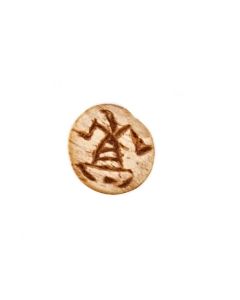 Western Asiatic button seal with scorpion
Western Asiatic button seal with scorpionInteresting button shaped seal from the time of the ancient Assyrian trade settlements in Syria and Anatolia. 19th to 18th cent. BC. From the Dr. Langenkamp collection, with a scientific note from Prof. Mayer-Opificius.
Price: on request Faience tile of the Djoser pyramid type
Faience tile of the Djoser pyramid typeEgyptian wall tile from the Old Kingdom, 2nd to 3rd dynasty. The tile type is known from the famous step pyramid of king Djoser.
Price: on request Massive Bronze Age spear head, possibly celtic
Massive Bronze Age spear head, possibly celticPerfectly preserved, large piece with beautiful patina. From an old German collection.
Price: on request Driking cup of the Troy type
Driking cup of the Troy typeSo-called Depas Amphikypellon from around 2500 BC. The famous type of drinking vessel from Troy as described in Homer's Iliad.
Price: on request Mycenaean seal with griffin
Mycenaean seal with griffinA wonderful and rare example of the Bronze Age Greek art of engraving stones. It shows a fantasy creature with lion body and bird of prey head. Mid-2nd Millennium BC.
Price: on request Mesopotamian stamp seal in bull shape
Mesopotamian stamp seal in bull shapeThe magnificent seal is from the Jemdet Nasr period. The stamp shows quadrupeds and a scorpion. Published in a book about the Epstein collection.
Price: on request Babylonian clay plaque with erotic scene
Babylonian clay plaque with erotic scenePanel with a religious function in the Old Babylonian Empire. The relief shows a man and a woman during the sexual act, with the woman drinking beer through a straw.
Price: on request Near Eastern bronze sword
Near Eastern bronze swordDouble-edged blade of a Bronze Age sword, the hilt missing. From the middle of the 2nd Millennium BCE.
Price: on request Old Babylonian cylinder seal with gods and inscription
Old Babylonian cylinder seal with gods and inscriptionScene with sun god Shamash and the Amorite god Amurru. The cuneiform writing names the owner of the seal, a faithful servant of these deities.
Price: on request Mesopotamian cylinder seal
Mesopotamian cylinder sealMade of beautiful red stone, worked with the drill. From the transitional period between Chalcolithic and Early Bronze Age in Mesopotamia.
Price: on request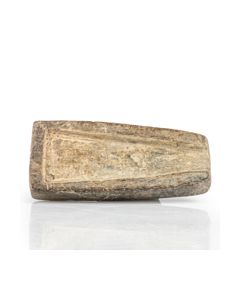 Bronze Age casting mould for a flat axe
Bronze Age casting mould for a flat axeOne half of a stone mould for bronze casting an axe head. The equipment is from a workshop of the 2nd Millennium BC, probably from the Carpathian Basin. From the famous Guttmann Collection. This mould was published in a work by Born and Hansen.
Price: on request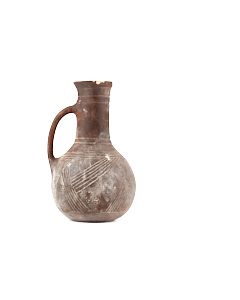 Anatolian clay jug with incised decoration
Anatolian clay jug with incised decorationThe Bronze Age vessel has wonderful linear decorative bands, the white filling of which contrasts with the dark slip. Circa 2500 to 2000 BC.
Price: on request Bronze Age bracelet with incised decoration
Bronze Age bracelet with incised decorationThe jewellery was made in Europe during the 2nd millennium BC. Nice, dark patina.
Price: on request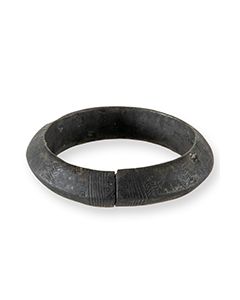 Bronze Age bracelet with incised decoration
Bronze Age bracelet with incised decorationThe jewellery was made in Europe during the 2nd millennium BC. Nice, dark patina.
Price: on request Slender Egyptian stone beaker
Slender Egyptian stone beakerThe small and tall stone vessel is made of alabaster. From the collection of Egyptologist Professor Wiedemann.
Price: on request Egyptian chalice
Egyptian chaliceThe thin-walled stone cup is reminiscent of a lotus bud. From the collection of Egyptologist Professor Wiedemann. 18th dynasty of Ancient Egypt.
Price: on request Egyptian faience figurine of Sekhmet
Egyptian faience figurine of SekhmetProtective amulet in the form of a statuette of the lion-headed goddess with a hieroglyphic inscription on the back. A wonderful and large faience from the Third Intermediate Period of Ancient Egypt.
Price: on request Egyptian stone beaker
Egyptian stone beakerThe elegant stone vase was probably used as an ointment vessel. 5th to 6th dynasty of ancient Egypt, Old Kingdom.
Price: on request Near Eastern cylinder seal
Near Eastern cylinder sealThe seal of black stone bears a scene with four noblemen or gods. Late Syrian, around 1500 BC.
Price: on request Mesopotamian cylinder seal
Mesopotamian cylinder sealThe marble seal bears a fight scene with lions. From the Early Dynastic or Akkadian period in the later 3rd Millennium BC.
Price: on request Egyptian model vessels of a founding ceremony
Egyptian model vessels of a founding ceremonyA group of seven miniature bowls and three miniature vases made of clay. Once filled with offerings and used ritually during a foundation stone laying ceremony. Dating to the Old Kingdom, around 2500 BC.
Price: on request Clay tablet with cuneiform text
Clay tablet with cuneiform textSmall cuneiform writing tablet with well preserved text on both sides.
Price: on request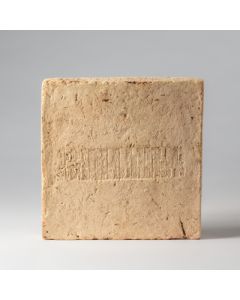 Sumerian brick with royal inscription
Sumerian brick with royal inscriptionClay tile from the temple of Eridu, donated around 2040 BC. Dedicated by Amar-Sin, king of the Third Dynasty of Ur. Studied for a research project in 1983.
€6,000 Published cypriot kylix, ex Christie's
Published cypriot kylix, ex Christie'sExcellently preserved. 1977 on exhibition in the Bielefeld Museum of Fine Arts. From an old German private collection, acquired 1972 at Christie's. Coming with an ArtLoss certificate.
Price: on request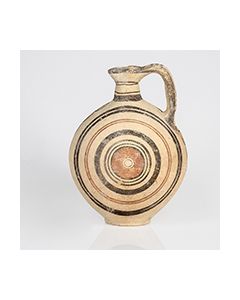 Large published Cypriot oinochoe
Large published Cypriot oinochoeDating to the early cypro-archaic period, so-called bichrome ware IV. From an old German private collection, acquired at Sotheby's in 1970. Coming with an ArtLoss certificate.
Price: on request

